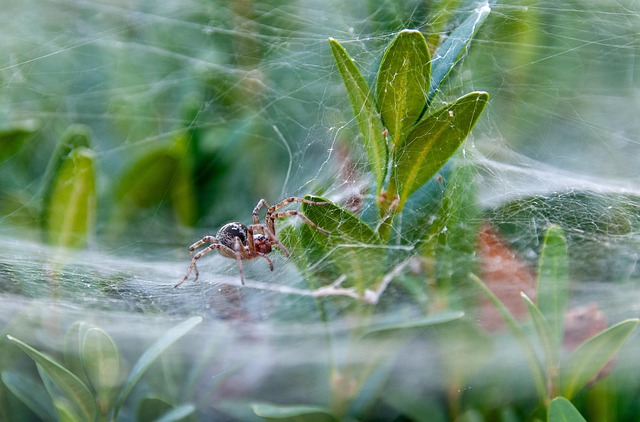To prevent spider infestations in basements, adopt a multi-step approach known as spider-proofing your home: identify and seal entry points, maintain cleanliness and clutter-free spaces, use natural deterrents and mechanical traps, ensure proper ventilation and humidity control, conduct regular inspections. This comprehensive strategy not only reduces spider attraction but also creates a more comfortable living environment by minimizing the risk of pest-related issues like mold and musty odors. Regular maintenance is key to keeping spiders at bay.
Spiders can infiltrate your home through various hidden entry points, from dark basements to cramped crawl spaces, even attic corners. This guide delves into specialized strategies for spider-proofing these often-overlooked areas. Learn how to identify and seal potential pathways, maintain optimal conditions, and implement effective treatments tailored to each space. Implement these practices for a comprehensive, long-term solution to keep spiders at bay and protect your home year-round.
Spider Prevention in Basements
Spider infestations in basements can be a common concern for many homeowners, but there are effective prevention strategies to implement. One of the key aspects of spider-proofing your home is sealing entry points. Inspect your basement for any cracks or gaps around windows, doors, or utility pipes, and fill these openings with caulk or weatherstripping. Regular cleaning and decluttering are also crucial; spiders often seek shelter in dark, cluttered spaces, so keeping your basement tidy will make it less appealing to them.
Consider using natural deterrents like lavender, mint, or citronella essential oils around entry points to create an unpleasant scent for spiders. You can also install mechanical spider traps strategically placed in hard-to-reach areas. Additionally, maintaining proper ventilation and humidity levels is essential; spiders are attracted to moist environments, so ensuring good air circulation and controlling humidity can significantly reduce their presence. Regular inspections and prompt removal of any found spiders or webs will further contribute to an effective spider-proofing strategy for your basement.
– Identifying entry points and common hiding spots
To spider-proof your home effectively, the first step is to identify potential entry points and common hiding spots. Spiders are adept at finding their way inside through small crevices, cracks, and openings around doors, windows, and utility pipes. They can also crawl up along exterior walls or be carried in on plants or outdoor furniture. Once inside, they seek out dark, secluded areas such as basements, attics, and crawl spaces—places where insects are abundant and undisturbed. By sealing these entry points with caulk or weatherstripping, and ensuring regular inspections of your home’s exterior, you significantly reduce the risk of an unwanted spider invasion.
Additionally, maintaining a clean and clutter-free environment is crucial. Regularly cleaning and vacuuming these problem areas can help remove spider food sources and discourage them from setting up camp. Store items in sealed containers, especially those that collect dust or attract insects, to make your home less appealing to spiders. Remember, even the smallest gap or crevice could be a potential entry point, so thorough inspection and proactive measures are key to spider-proofing your home successfully.
– Using physical barriers and sealing techniques
To spider-proof your home effectively, especially in basements, attics, and crawl spaces, physical barriers and sealing techniques are essential components. Start by installing fine mesh wire or plastic sheeting over vents and other openings to prevent spiders from entering these areas. Ensure all cracks and crevices are sealed with caulk or foam to close off potential entry points. This step is crucial for cutting off access routes and keeping spiders out.
Additionally, consider using spider traps or sticky barriers in hard-to-reach corners and along walls. These physical deterrents can capture spiders without causing them harm. Regularly inspect and maintain these barriers to ensure their effectiveness over time, as spiders are resourceful and may find ways to bypass them.
– Best practices for maintaining cleanliness and minimizing moisture
Maintaining a clean and dry environment is essential for preventing issues like mold growth, pest infestations, and musty odors in basements, attics, and crawl spaces. Regular cleaning and inspection are key best practices. Start by decluttering these areas to eliminate potential hiding spots for pests, especially spiders. Then, use a damp cloth or sponge to wipe down surfaces, removing dust and web residue. Address any visible moisture issues immediately—repair leaks, ensure proper ventilation, and consider using dehumidifiers if necessary. Regularly vacuum and sweep floors, paying special attention to corners and crevices where spiders might dwell.
Additionally, spider-proofing your home involves sealing entry points. Fill cracks and gaps around windows, doors, and pipes with caulk or foam insulation. Install weatherstripping on doors for a tight seal. Keep gutters clean to prevent water buildup, which can lead to wood rot and attract pests. Regular maintenance and vigilance are crucial to maintaining a spider-free and healthy living space.
To effectively spider-proof your home, it’s crucial to implement specialized prevention strategies for key areas like basements, attics, and crawl spaces. By identifying and sealing entry points, using physical barriers, maintaining cleanliness, and minimizing moisture, you create an inhospitable environment for spiders. These measures not only prevent unwanted guests but also ensure a safer, more comfortable living space for your family. Regular maintenance and proactive measures are key to keeping these pesky arachnids at bay.
